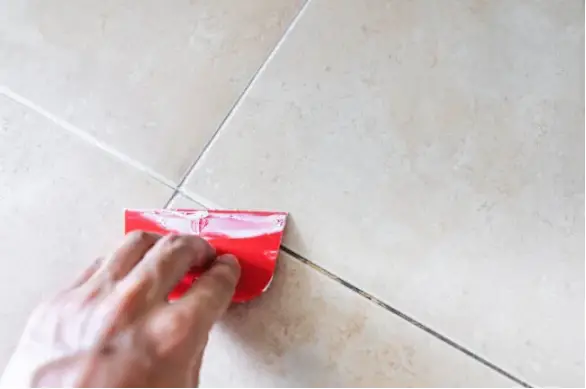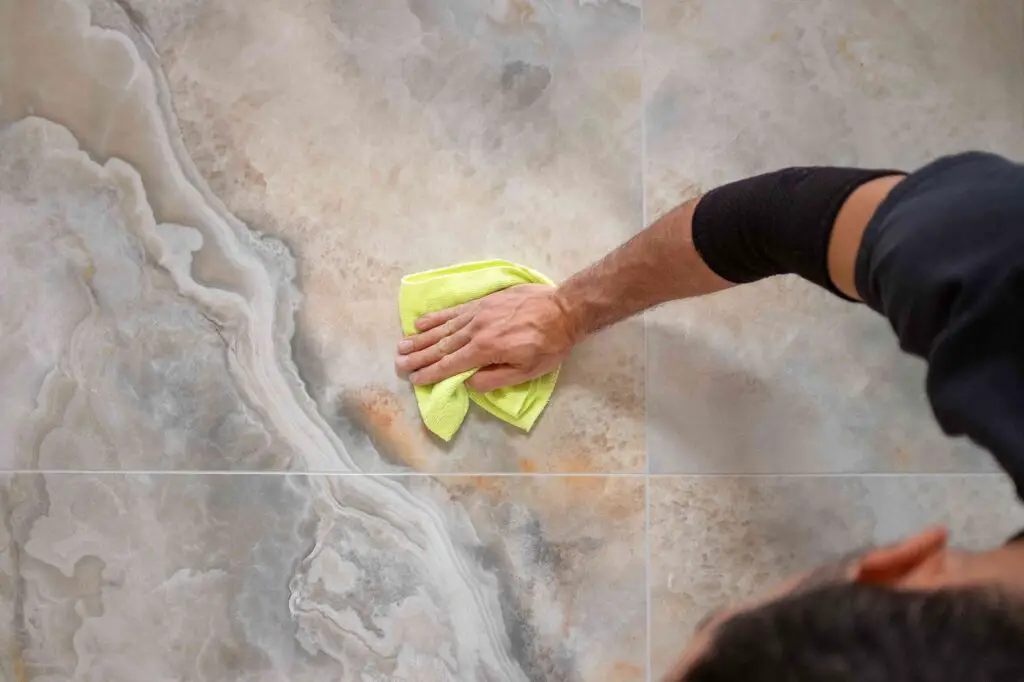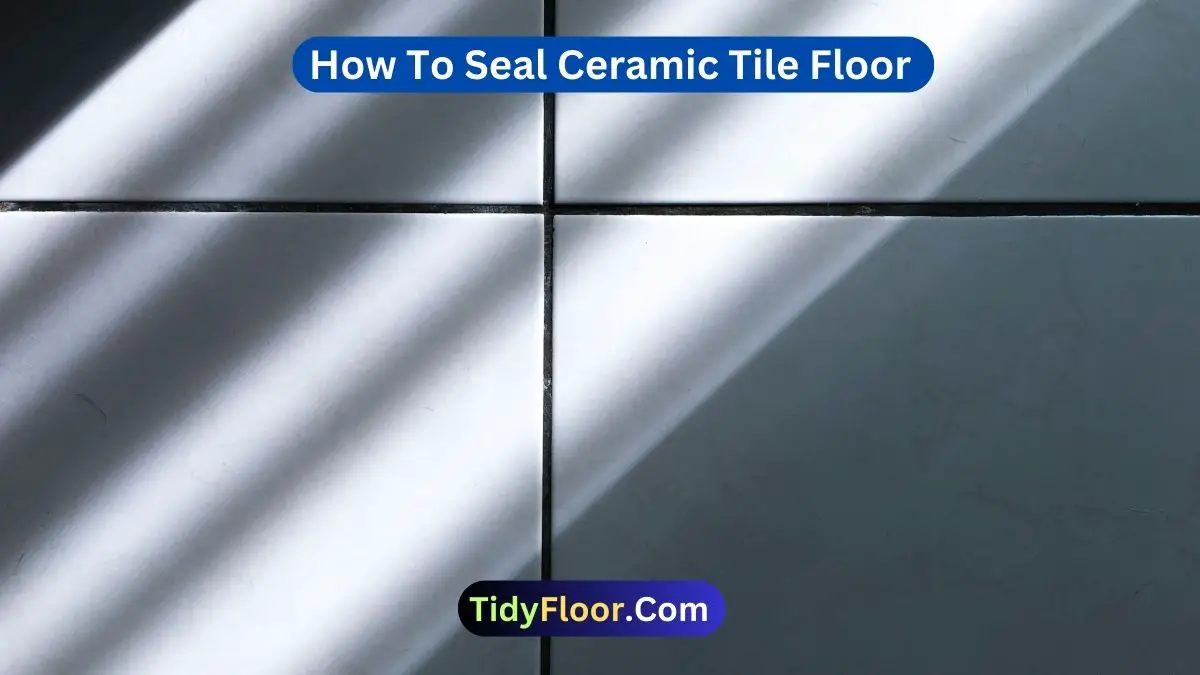Ceramic tile floors are durable and beautiful. But they need protection from stains and wear. Sealing them helps keep them looking great for years. Without knowing the proper technique on how to seal ceramic tile floors, you can’t seal effectively.
To seal a ceramic tile floor, clean thoroughly, choose a suitable sealer, apply it evenly with a brush or roller, and let it dry. Apply multiple coats as needed, following manufacturer instructions, for optimal protection and durability.
Stick with this article to learn the steps to seal ceramic tile floors. Also, you can distinguish solvent and non-solvent sealers easily. So read the article to know in detail.
8 Steps-by-Steps How To Seal Ceramic Tile Floor:

Sealing your ceramic tile floor is essential for preserving its beauty and durability. Follow these 8 simple steps to effectively seal your ceramic tile floor and protect it against stains, moisture, and wear.
Necessary Materials And Tools:
Materials:
- Ceramic tile sealer (penetrating or surface sealer, depending on your preference and tile type);
- Mild detergent;
- Warm water;
- Clean, dry cloths or towels;
- Painter’s tape (if needed to protect adjacent surfaces);
- Buffing pad (optional, for final polishing).
Tools:
- Broom or vacuum cleaner;
- Mop;
- Bucket;
- Paintbrush, roller, or sprayer for applying the sealer;
- Protective gloves (optional but recommended);
- Safety goggles (optional but recommended);
- Drop cloth or plastic sheeting to protect surrounding areas;
- Floor fan or adequate ventilation for drying.
Step 1: Clean the Floor
Thoroughly sweep or vacuum the floor to remove any dust, dirt, or debris. Use a mild detergent and warm water to mop the floor, ensuring all stains and spills are removed. Allow the floor to dry completely before proceeding.
Step 2: Choose the Right Sealer
Select a high-quality ceramic tile sealer suitable for your specific type of tile and the level of traffic in the area. There are different types of sealers available, including penetrating sealers and surface sealers. Read the instructions carefully before purchasing.
Step 3: Test the Sealer
Before applying the sealer to the entire floor, perform a small test in an inconspicuous area to ensure compatibility and desired results. This will help you avoid any unexpected reactions or issues with the sealer.
Step 4: Apply the Sealer
Using a clean paintbrush, roller, or sprayer, apply the sealer evenly over the surface of the ceramic tiles. Work in small sections to ensure thorough coverage and avoid streaks or puddles. Follow the guidelines regarding the application technique, drying time, and number of coats required.
Step 5: Allow Drying Time
After applying the sealer, allow the floor to dry completely according to the instructions. This may take several hours or even overnight, depending on the type of sealer used and environmental conditions.
Step 6: Apply Additional Coats (If Necessary)
If recommended by the manufacturer or desired for extra protection, apply additional coats of sealer following the same process as before. Allow each coat to dry completely before applying the next one.
Step 7: Buff the Surface (Optional)
Once the final coat of sealer has dried, you may choose to buff the surface of the ceramic tile floor with a clean, dry cloth or buffing pad to enhance shine and smoothness.
Step 8: Maintain the Sealed Floor
Regular maintenance is essential to preserve the effectiveness of the sealer and keep your ceramic tile floor looking its best. Clean up spills promptly, sweep or vacuum regularly to remove debris, and avoid using harsh chemicals or abrasive cleaners that could damage the sealant.
7 Considerations When Cleaning And Preparing Ceramic Tiles For Sealing:

When cleaning and preparing ceramic tiles for sealing, there are several important considerations to keep in mind to ensure the best results:
#1- Tile Type:
Different types of ceramic tiles may require different cleaning and preparation methods. Porcelain, glazed, and unglazed ceramic tiles each have specific characteristics that influence how they should be cleaned and prepared for sealing. Consult with a professional if you’re unsure about the appropriate approach for your tile type.
#2- Surface Condition:
Inspect the ceramic tile surface for any visible damage, stains, or residues. Address any issues such as cracks, chips, or grout damage before proceeding with cleaning and sealing. Surface imperfections can affect the adhesion and performance of the sealer.
#3- Cleaning Products:
Choose cleaning products that are suitable for ceramic tiles and grout. Avoid harsh or abrasive cleaners that can damage the tile surface or grout. Opt for mild detergents or specialized tile and grout cleaners that effectively remove dirt, grime, and stains without causing damage.
#4- Grout Cleaning:
Pay special attention to cleaning the grout lines between the tiles. Grout tends to accumulate dirt, grime, and stains over time, affecting the overall appearance of the tiled floor. Use a grout cleaner and a stiff brush to thoroughly clean the grout lines before sealing.
#5- Surface Preparation:
Ensure the tile surface is clean, dry, and free of any residues before applying the sealer. Remove any dust, dirt, or debris by sweeping or vacuuming the floor. Mop the floor with a mild detergent and warm water to remove stains and spills, and allow it to dry completely before sealing.
#6- Test Patch:
Before applying the sealer to the entire floor, perform a test patch in an inconspicuous area to ensure compatibility and desired results. This allows you to assess the sealer’s performance and appearance on your specific tile and grout before proceeding with the full application.
#7- Environmental Conditions:
Consider the environmental conditions such as temperature and humidity when cleaning and preparing ceramic tiles for sealing. Ideal conditions for applying sealer typically include moderate temperatures and low humidity to facilitate proper drying and curing.
Water-based VS Solvent-based Sealers For Sealing Ceramic Tile Floor:
Discovering the best sealer for your ceramic tile floor involves considering water-based and solvent-based options. Understanding their differences is key to making the right choice for protecting and enhancing your floor’s longevity and appearance.
| Aspect | Water-based Sealers | Solvent-based Sealers |
| Performance | Good protection against stains and water penetration. | Excellent durability and resistance to heavy foot traffic, chemicals, and UV exposure. |
| Application Ease | Easier to apply and clean up. | Requires careful application due to strong odor and longer drying time. |
| Drying Time | Dries faster, allowing for quicker recoating or use of the sealed area. | Longer drying time compared to water-based sealers. |
| Odor | Lower odor, making them more pleasant to work with. | Strong odor requires adequate ventilation during application. |
| Durability | May not be as durable as solvent-based sealers, especially in high-traffic areas or outdoor environments. | Offers superior durability and long-lasting protection. |
| Environmental Impact | Lower levels of volatile organic compounds (VOCs), reducing air pollution and potential health risks. | Higher levels of VOCs contribute to air pollution and may have adverse health effects. |
| Safety | Generally safer to use and handle, posing fewer health risks to applicators and occupants. | Requires proper handling and ventilation to minimize exposure to harmful fumes. |
Related Questions
Does Ceramic Floor Tile Need To Be Sealed?
Ceramic floor tiles are naturally resistant to water and stains. However, sealing them can provide additional protection against dirt, grime, and spills, especially in high-traffic areas or where moisture is present. Sealing the tiles can also enhance their appearance by bringing out their natural colors and textures.
Also, sealing helps to prevent grout from staining or discoloration. While sealing is not always mandatory for ceramic tiles, it’s a recommended step to prolong their lifespan and maintain their aesthetic appeal.
What Are The Long-Lasting Tile Sealers For Ceramic Tile Floors?
For long-lasting protection of ceramic tile floors, consider penetrating sealers like Stone tech Bullet Proof Sealer or Miracle Sealants 511 Impregnation. These sealers penetrate deep into the tile and grout, providing durable protection against stains, water, and wear.
Solvent-based sealers such as Aqua Mix Sealer’s Choice Gold are also renowned for their longevity and resilience against heavy traffic and harsh conditions. Proper application and regular maintenance ensure these sealers maintain their effectiveness for years to come.
What Happens If You Don’t Seal The Tile Floor?
If you don’t seal a ceramic tile floor, it becomes more susceptible to stains, dirt, and moisture penetration. Glazed tiles and grout lines can absorb liquids, leading to discoloration, staining, and even mold or mildew growth over time.
Without a protective sealant, the tile’s surface may become harder to clean, and grout lines may deteriorate more quickly. Sealing ceramic tile floors helps to maintain their appearance, prolong their lifespan, and protect against damage from everyday wear and tear.
What Are The Common Signs That Indicate A Ceramic Tile Floor Needs Sealing?
Signs indicating a need for sealing include stains and discoloration on tile surfaces due to liquid absorption, and darkened grout lines from moisture penetration. Moreover, water pooling or seeping into tiles or grout signals inadequate protection.
Difficulty cleaning spills or dirt, wear and tear in high-traffic areas, and loss of shine on glazed tiles are also indicative. Brittle or crumbling grout is a clear indication of prolonged exposure. Regular inspection helps determine when resealing is necessary to maintain tile integrity and appearance.
How Long Does It Take For A Sealed Ceramic Tile Floor To Dry Completely?
The drying time for a sealed ceramic tile floor depends on factors like the type of sealer used, humidity levels, and ventilation. Usually, water-based sealers dry faster, often within a few hours, while solvent-based sealers may take longer, sometimes up to 24 hours or more.
Adequate ventilation can expedite the drying process. It’s crucial to avoid foot traffic or placing heavy objects on the floor until it’s completely dry to ensure the sealer sets properly and provides effective protection against stains and moisture.
Are There Any Eco-Friendly Or Non-Toxic Options For Sealing Ceramic Tile Floors?
There are eco-friendly and non-toxic options for sealing ceramic tile floors. Water-based sealers are generally considered more environmentally friendly because they have lower levels of volatile organic compounds (VOCs) compared to solvent-based sealers. Look for sealers labeled as “low VOC” or “zero VOC” to minimize air pollution and potential health risks.
In addition, some manufacturers offer eco-friendly sealers made from natural ingredients such as plant-based oils or water-based polymers. These options provide effective protection for ceramic tile floors while reducing environmental impact and ensuring safer indoor air quality.
Conclusion
Sealing ceramic tile floors is essential for protecting them against stains, moisture, and wear. By following the steps on how to seal ceramic tile floors, you can effectively seal your floor, prolonging its lifespan and maintaining its appearance. Remember to choose the appropriate sealer for your needs, whether it’s water-based for eco-friendliness or solvent-based for durability.


